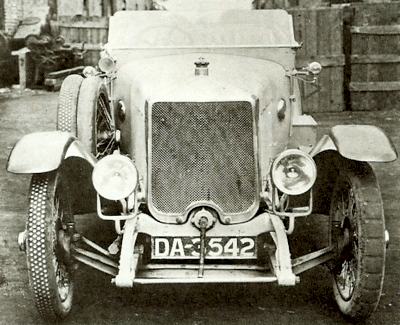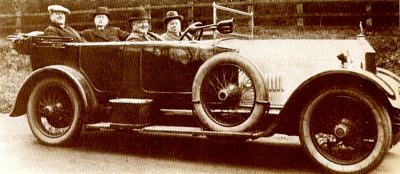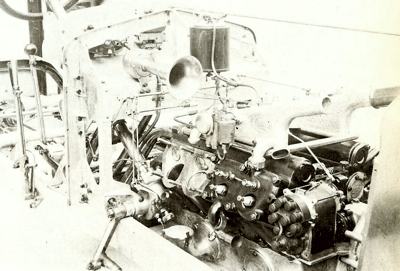The Bellis & Morcom Steam-Engineering Co.
Sydney S. Guy was, by training, a steam man - which during the Edwardian era was not all that unusual. Guy learned his trade with the Bellis & Morcom steam-engineering company. In the early days of motoring, he transferred his allegiance to internal combustion, joining
Humber; he later moved to Sunbeam in Wolverhampton, becoming Works Manager under Louis Coatalen.
Guy helped to build the successful Sunbeam racers of the 1912-1913 era, and became convinced that the principles of lightness followed in the design of racing cars could just as well be applied to commercial vehicles, most of which were, at that time, excessively heavily built. Accordingly, he resigned from Sunbeam at the end of 1913 to form his own company, which was floated with the aid of friends in May 1914, occupying a factory at Failings Park, Wolverhampton, in the UK.
The Guy truck, or lorry as the Brits would refer to it, was a 30 cwt vehicle, using a pressed-steel car-type chassis, with the engine and gearbox carried in a subframe that was three-point mounted in the main chassis to minimise distortion. Its four-speed gearbox had direct drive on third, top being an overdrive for use when the truck was running unladen; there was a governor controlled by road speed rather than engine speed which limited progress to 30 mph without restricting the engine revolutions in the intermediate gears.
In 1914, Guy Motors built its first passenger-carrying vehicle, a toastrack-bodied mail car which operated between Achnasheen and Aultbea in Wester Ross, Scotland. This twelve-seater vehicle ran on pneumatic tyres, an unusual departure for those days, when most commercials of this size wore solid tyres. During World War 1, Guy built firing mechanisms for depth charges, as well as ABC Wasp aero engines.
Both Guy and Clyno subsequently received contracts to build ABC Dragonfly aero engines, the two companies racing to produce the first engine, but the Dragonfly did not run until Armistice Day, by which time there was no further use for it. The post-war market for trucks was depressed by the vast numbers of ex-military vehicles released onto the private sector by the Army Disposal Board. There was, however, an apparently insatiable demand for cars, which determined Sidney Guy to break into this rather lucrative field.
The Guy V8
Like the commercial vehicles produced by the company, the Guy car was of extremely advanced design, being powered by a V8 engine. Although this unit is sometimes claimed to be Britain's first V8, we dont believe this is actually the case: in 1906, both Adams and New Leader cars had listed V8s, which were produced in limited numbers, and contemporary with the Guy was an obscure and short-lived Vulcan model. However, the V8 was a well established feature of American and French luxury, models well before the appearance of the new Guy car.
 1919 Guy V8 prototype.
1919 Guy V8 prototype.
 Guy V8 Tourer, which was first shown at the 1919 Olympia Motor Show. Deliveries began in 1920 and, during the model's four-year lifespan, around 150 would be sold.
Guy V8 Tourer, which was first shown at the 1919 Olympia Motor Show. Deliveries began in 1920 and, during the model's four-year lifespan, around 150 would be sold.
 1928 Guy Bus.
1928 Guy Bus.

The Guy V8 engine, which had 2 cylinder blocks set at 90 degrees and featured detachable cylinder heads. |
The two cylinder blocks of the Guy were set at 90 degrees, and featured inclined side valves and detachable
cylinder heads; the 25.7 hp, 4-litre engine was carried in a three-point-mounted sub frame similar to that of the Guy trucks, although the prototype installation had been made, apparently, in a sporting Sunbeam Chassis. The chassis of the production Guy cars was quite conventional in its layout, being carried on semi-elliptic springs all round.
The best (and somewhat revolutionary) feature, however, was the automatic chassis lubrication system. Designed by E. D. J. Buckney, and first appearing on the market in the summer of 1920, the lubriciation system came into action every time the steering went on to full right lock, when a cam on the steering column operated a plunger pump that forced oil to all the moving parts of the chassis.
Looking at the complex array of copper pipes necessary to the automatic lubrication, a Guy agent quipped, 'I see you have a telephone in every bedroom!' Three Guy V8s were shown at the 1919 Olympia Motor Exhibition: a polished chassis, a three-seater coupe by Cole and a Guy-bodied five-seat open tourer.
The last car had particularly good looking machine-turned, semi-polished aluminium coachwork, and was much admired by King George V, who displayed a 'lively interest' in the car's specification. Chassis price was UK£1175, while the open tourer cost UK£1475; by 1923, the cost of the V8 chassis had fallen to UK£875.
Deliveries began in 1920, and during the model's four-year lifespan, some 150 V8s were sold, no mean figure for a car selling in this price bracket. The works retained one of the V8s as a hack vehicle until the late 1930s. Two smaller Guy cars, both in-line fours without the automatic lubrication system, were announced in 1921. The smallest was a 12 hp, priced at UK£475 in chassis' form UK£660 complete with four-seat-tourer coachwork, while the larger model had a 15.9 hp power unit (a bored-out 16.9 hp engine was available on export versions of this car). Chassis price of the 15·9 Guy was UK£550; four-seater touring
bodywork added another £200.
Feathers in our Cap
A new four, the 13/36, made its debut at the 1923 Olympia Show. The power unit of this car apparently used one block of the V8, as the cylinder dimensions of the two cars were identical at 72 mm bore x 120 mm stroke. However, the 13/36 had splash lubrication rather than the pressure system fitted to the larger car.
The chassis was more advanced in one feature, however, as it had four-wheel braking, which in those days was normally only found on expensive sporting chassis. At a chassis price of UK£395 (saloon coachwork was UK£100 extra), the Guy 2-Iitre could hardly be regarded as expensive, but it was doomed to a short production life, as the market trends of a few years earlier had completely reversed themselves.
By now, there was a keen demand for trucks, while, as Sidney Guy himself remarked, 'One could hardly give away a second-hand car, let alone sell a new one'. So, sometime in 1924, the decision was made to drop cars completely, and concentrate on the commercials which were already being marketed under the famous 'feathers in our cap' trademark, which features a red-Indian in full headdress.
That was not the end of Guy's connection with motor cars of quality though, for in 1926, they acquired the old-established Wulfrunian firm of Star Motors, and Star cars, trucks and buses were produced under their aegis until 1932.
Eventually a firm of car makers took over Guy - that was in
1961, and the company was
Jaguar. Sydney Guy himself, after heading the company for almost half-a-century, had retired in 1957 to Albrighton, near Wolverhampton.
At the time of the Jaguar take-over, the name of the company was changed to "Guy Motors (Europe) Ltd" which may hint at a 1961 management vision of the future: the name reverted to "Guy Motors Ltd" in
1966, however.
The Big J
Guy-badged buses ceased production in 1964: by then the company had developed a completely new range of trucks: the Big J models. The Big J was designed around a new Cummins V6 engine, and was intended for motorway operation. In 1966, Jaguar became part of the British Motor Holdings. In 1968, Guy Motors became part of British Leyland Motor Corporation after the merger of British Motor Holdings and
Leyland Motor Corporation. Sidney Guy, by now retired for more than ten years, died at home in Albrighton aged 86 on 21 September 1971 leaving a widow, two sons and a daughter. Guy Motors' factory was closed in 1982.



